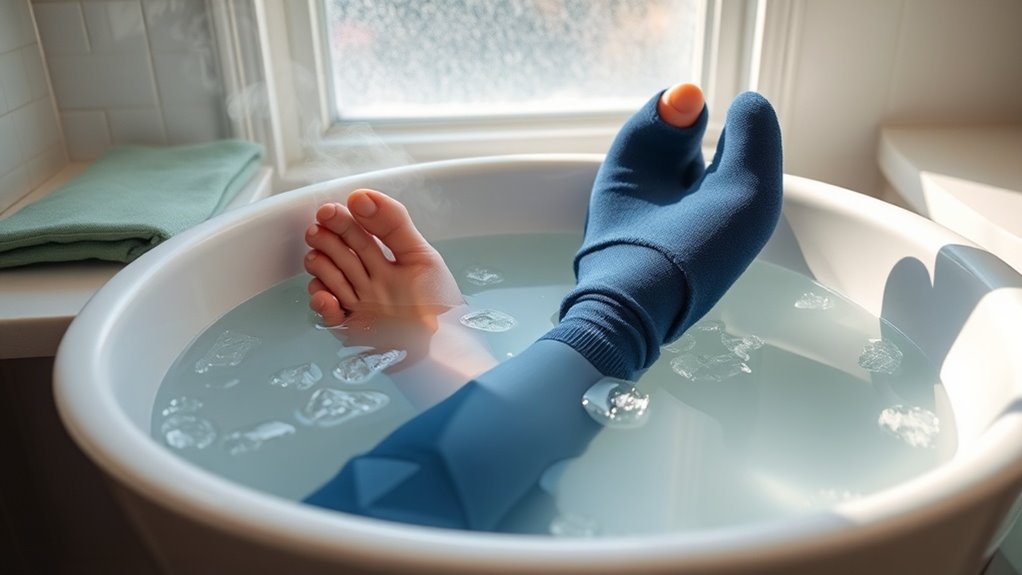How I Reduce Foot Swelling After Long Walks
Understanding Why Feet Swell During Long Walks
During prolonged walking, your feet experience edema due to increased hydrostatic pressure and gravitational forces acting on the lower extremities.
Your circulatory system struggles to pump blood against gravity, leading to fluid accumulation in peripheral tissues.
This vascular congestion, combined with mechanical stress on plantar fascia and metatarsals, contributes to swollen feet. Relief requires understanding these physiological mechanisms. Additionally, staying hydrated can significantly help reduce the swelling by flushing out excess salt from the body.
Immediate Relief Methods After Walking
Once you’ve completed your long walk, implementing immediate interventions can help mitigate the vascular congestion and edema in your feet.
Elevate your extremities 15-20 degrees above heart level, apply cold compression therapy for 15-20 minutes, and perform ankle pump exercises. You’ll also want to remove constrictive footwear and consider wearing compression socks to promote venous return. Additionally, incorporating a foot soak with Epsom salt can further aid in reducing inflammation and drawing out excess fluid.
Recovery Tips Using Cold and Heat Therapy
While alternating cold and heat therapy provides optimal results for post-walk foot recovery, proper timing and technique are essential.
The thermotherapy protocol maximizes circulation and reduces edema.
- Apply cryotherapy for 15 minutes using ice packs at 40°F (4°C)
- Rest for 20 minutes between modalities
- Follow with thermotherapy using moist heat at 104°F (40°C) for 20 minutes.
Additionally, foot soaks improve circulation and encourage fluid drainage, helping to further reduce swelling.
Recommended Stretches for Swollen Feet
After applying thermal therapies, gentle stretching exercises help reduce edema and promote lymphatic drainage in swollen feet.
Perform ankle circles, focusing on dorsiflexion and plantarflexion movements.
Target the plantar fascia by flexing your toes against resistance.
Execute calf stretches while maintaining posterior tibial alignment.
These exercises facilitate venous return and decrease interstitial fluid accumulation in the distal extremities. Engaging in these stretches may also complement increasing circulation, which is vital for managing swelling.
Essential Equipment and Products for Relief
To mitigate post-ambulatory edema, you’ll need compression socks or sleeves that provide graduated pressure between 15-20 mmHg to enhance venous return and reduce fluid accumulation in the distal extremities.
Cold therapy devices, including anatomically designed ice packs and cryotherapy rollers, can effectively constrict blood vessels and decrease inflammation in the affected pedal regions.
These therapeutic tools, when used in conjunction with proper elevation techniques, create an optimal environment for reducing interstitial fluid retention and promoting lymphatic drainage. Additionally, incorporating Epsom salt foot soaks can help enhance relaxation and reduce swelling further.
Compression Socks and Sleeves
Compression socks and sleeves represent one of the most effective medical interventions for managing post-ambulatory edema.
These gradient pressure garments optimize venous return and reduce interstitial fluid accumulation through:
- Graduated compression levels (20-30 mmHg) that enhance peripheral circulation
- Strategic anatomical zones targeting ankle-to-calf lymphatic drainage
- Medical-grade elastomeric fibers providing consistent circumferential pressure
Ice Packs and Rollers
Three essential therapeutic tools – ice packs, cold rollers, and cryotherapy massage devices – provide targeted relief for post-ambulatory pedal edema.
Apply ice packs for 15-20 minute intervals to reduce inflammation.
Cold rollers facilitate myofascial release while delivering cryotherapy benefits. For optimal results, utilize these modalities within 30 minutes post-exercise.
You’ll accelerate recovery by combining ice therapy with plantar fascia manipulation using specialized massage tools.
Prevention Strategies for Future Walks
While preventing foot edema requires proactive measures, you’ll find several evidence-based strategies to minimize swelling during future walks.
-
Select compression socks with graduated pressure (20-30 mmHg) to enhance venous return and reduce interstitial fluid accumulation.
-
Maintain proper hydration with electrolyte balance to regulate osmotic pressure.
-
Choose anatomically appropriate footwear with adequate arch support and metatarsal cushioning.
When to Seek Medical Attention
Although most post-walk foot swelling resolves with conservative measures, certain symptoms warrant immediate medical evaluation.
Seek emergency care if you experience severe pain, numbness, cold or bluish toes, fever with redness, or swelling that doesn’t improve after 24 hours.
Additionally, contact your healthcare provider if you notice recurring swelling episodes, especially when accompanied by shortness of breath or chest pain.
